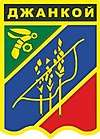Dzhankoy
Dzhankoy or Jankoy[1] (Ukrainian and Russian: Джанкóй, Crimean Tatar: Canköy, Yiddish: דזשאנקאיע) is a town of regional significance in the north of the Crimea. It also serves as administrative center of Dzhankoy Raion although it is not a part of the raion (district). Population: 38,622 (2014 Census).[2]
Dzhankoy Джанкой Canköy | |
|---|---|
 Coat of arms | |
.svg.png) Dzhankoy Location of Dzhankoy within Crimea | |
| Coordinates: 45°42′31″N 34°23′36″E | |
| Country | Disputed: |
| Republic | Crimea |
| Region | Dzhankoy city municipality |
| Area | |
| • Total | 26 km2 (10 sq mi) |
| Elevation | 20 m (70 ft) |
| Population (2014) | |
| • Total | 38,622 |
| • Density | 1,648.5/km2 (4,270/sq mi) |
| Time zone | UTC+3 (MSK) |
| Postal code | 96100 — 96114 |
| Area code(s) | +7-36564 |
| Website | dzhankoy |
The name Dzhankoy is often translated into English from Crimean Tatar as "spirit-village" (can — spirit, köy — village) -Canköy. But the real meaning of this name is "new village": canköy < cañı köy (cañı is "new" in the northern dialect of Crimean Tatar).
In the city there are many types of industrial factories, some of which are: automobile, reinforced concrete, fabric, meat, and others. Dzhankoy also contains professional technical schools.
Geography
Dzhankoy serves as the administrative center of the Dzhankoy Raion. It is located about 93 kilometres (58 mi) from the Crimean capital, Simferopol. Two railroad lines, Solionoye ozero-Sevastopol and Armyansk-Kerch, cross Dzhankoy. In 1926, Dzhankoy was granted city status.
Transport
Dzhankoy is a transport hub. Through the city pass two major railways of the peninsula as well as two major European highways. It has two railroad terminals - the central one, where only passenger and fast trains stop and the suburban one - where only suburban trains, known as elektrichkas, are allowed.
Demographics
| Year | #Inhabitants |
|---|---|
| 1805 | 173 |
| 1926 | 8,310 |
| 1939 | 19,576 |
| 1970 | 43,000 |
| 1989 | 53,464 |
| 2001 | 42,861 |
Climate
Dzhankoy's climate is mostly hot in the summer, and mild in the winter. The average temperature ranges from −2 °C (28 °F) in January, to 23 °C (73 °F) in July. The average precipitation is 420 millimetres (17 in) per year.
In popular culture
Dzhankoy is the subject of a popular Yiddish song "Hey! Zhankoye," as popularized by Pete Seeger, and by Theodore Bikel, a Soviet-era song praising the life of Jews on collective farms in Crimea.[3][4][5]
Gallery
- Stepna River in Dzhankoy
- City centre of culture
 Downtown Dzhankoy
Downtown Dzhankoy- Street intersection in Dzhankoy
References
- "6 KILOGRAMMES OF MERCURY FOUND OUT IN THE CENTRE OF JANKOY IN CRIMEA".
- Russian Federal State Statistics Service (2014). "Таблица 1.3. Численность населения Крымского федерального округа, городских округов, муниципальных районов, городских и сельских поселений" [Table 1.3. Population of Crimean Federal District, Its Urban Okrugs, Municipal Districts, Urban and Rural Settlements]. Федеральное статистическое наблюдение «Перепись населения в Крымском федеральном округе». ("Population Census in Crimean Federal District" Federal Statistical Examination) (in Russian). Federal State Statistics Service. Retrieved January 4, 2016.
- Kann, Kenneth L. (1993). Comrades and Chicken Ranchers. Cornell University Press. pp. 87–88.
- Silverman, Jerry (2010). Songs of the Jewish People. Mel Bay Publications. pp. 54–55.
- "Video Archives: Yosl Kogan, Bershad Ghetto". AHEYM: Archives of Historical and Ethnographic Yiddish Memories. Indiana University (Bloomington), College of Arts and Sciences. Retrieved 27 February 2014.
External links
- The murder of the Jews of Dzhankoy during World War II, at Yad Vashem website.